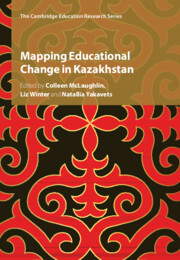Book contents
- Mapping Educational Change in Kazakhstan
- Mapping Educational Change in Kazakhstan
- Copyright page
- Dedication
- Contents
- Figures
- Tables
- Contributors
- Preface
- Acknowledgements
- Introduction
- Part I Foundations of Scaling Up
- 1 Rationale for and Perceptions of the Educational Reform in Kazakhstan
- 2 The New Educational Structures and Networks as Drivers of National Modernisation
- 3 The Translation of ‘World-Class’ Academic Research Practices in Kazakhstan
- 4 Teaching Science in English in Secondary Schools in Kazakhstan
- 5 Diversity, Equity and Inclusion in Kazakhstani Schools
- Part II Piloting Initiatives and Scaling Up to the Whole System
- Part III Evidence of Implementation
- Conclusions
- Select Bibliography: School-Level Educational Reforms in Kazakhstan, 2011–2022
- Index
- References
4 - Teaching Science in English in Secondary Schools in Kazakhstan
Policy and Practice Perspectives
from Part I - Foundations of Scaling Up
Published online by Cambridge University Press: 09 November 2023
- Mapping Educational Change in Kazakhstan
- Mapping Educational Change in Kazakhstan
- Copyright page
- Dedication
- Contents
- Figures
- Tables
- Contributors
- Preface
- Acknowledgements
- Introduction
- Part I Foundations of Scaling Up
- 1 Rationale for and Perceptions of the Educational Reform in Kazakhstan
- 2 The New Educational Structures and Networks as Drivers of National Modernisation
- 3 The Translation of ‘World-Class’ Academic Research Practices in Kazakhstan
- 4 Teaching Science in English in Secondary Schools in Kazakhstan
- 5 Diversity, Equity and Inclusion in Kazakhstani Schools
- Part II Piloting Initiatives and Scaling Up to the Whole System
- Part III Evidence of Implementation
- Conclusions
- Select Bibliography: School-Level Educational Reforms in Kazakhstan, 2011–2022
- Index
- References
Summary
This chapter offers insights into the policy and practice of science education in English in Kazakhstan. Science education is currently seen as synonymous with education in English through the Content and Language Integrated Learning (CLIL) approach, but this position has evolved over time as the policy has expanded across schools. Previous studies in Kazakhstan have found that teachers hold positive attitudes towards teaching science in English but experience practical challenges in teaching methods and linguistic resources. To better understand these challenges, a case study of science teachers was conducted jointly by the University of Cambridge and the Nazarbayev University Graduate School of Education (NUGSE) in 2019. Observations were conducted and evaluated using a modified Reformed Teaching Observation Protocol (RTOP). The data indicate a dearth of innovation and transformation of STEM education, and of application of CLIL pedagogies. Overall, these findings seem to point to the need for sustained professional development that lasts over an extended time so that teachers can understand how to implement STEM education reform efforts and CLIL pedagogy.
Keywords
- Type
- Chapter
- Information
- Mapping Educational Change in Kazakhstan , pp. 59 - 74Publisher: Cambridge University PressPrint publication year: 2023

